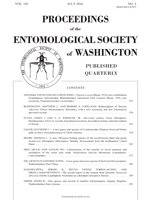We document cannibalism in young larvae of Hadena ectypa Morisson, a rare noctuid moth that oviposits in flowers of its host plant Silene stellata L. In 2012 and 2013, we observed high Hadena ectypa adult activity in early flowering season of Silene stellata, when flower density was low. As a result, co-occurrence of related as well as unrelated eggs within the same flower was prevalent. A Hadena ectypa larva feeds upon ovules and develops through the first three instars within the initial flower before becoming mobile between flowers. Therefore, the clustering of eggs could potentially inflict resource limitation on the young, co-occurring larvae, which could in turn favor cannibalism. We performed feeding trials that imitated this crowded condition in laboratory environment and recorded high overall frequency of cannibalism in young larvae (71.43 percent, n=70). Furthermore, cannibalism occurred at equal frequencies between siblings and between nonsiblings (X2=0.023, P>0.90, df = 1). In addition, head capsule widths of the cannibalistic larvae were significantly greater than those of the non-cannibalistic larvae (t = -12.187, df = 55.503, P<0.0001). The slow development of noncannibals was most likely caused by the limitation of food. Cannibalism provides a potential mechanism of regulating larval density and can be important in stabilizing the interaction of Hadena ectypa with its host plant.
How to translate text using browser tools
5 August 2016
Cannibalism During Early Larval Development of Hadena ectypa Morrison (Lepidoptera: Noctuidae)
J. Zhou,
M. R. Dudash,
C. B. Fenster
ACCESS THE FULL ARTICLE
Feeding trial
inclusive fitness
larval behavior
ovary
oviposition behavior
plant-insect interaction
seed predation





